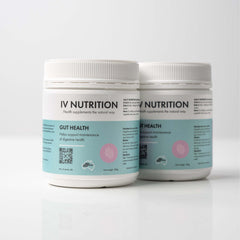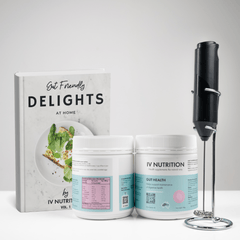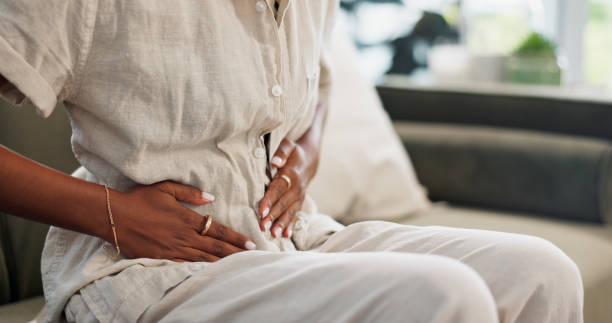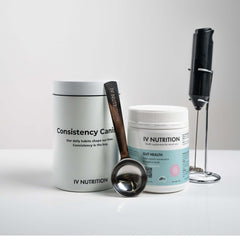How to Check if You Have IBD: The Clinical Guide to Spotting the Signs and Supporting Your Gut Naturally
Inflammatory Bowel Disease (IBD) isn’t just about having “a sensitive stomach.” It’s a chronic, immune-driven condition that can affect everything from your digestive system to your mood, nutrition, and overall health. But how do you actually know if you have it?
If you’ve found yourself Googling “Why does my stomach hurt all the time?” or “Why do I always have diarrhea after eating?” — you’re not alone. And more importantly, you might be overdue for a proper checkup.
This guide walks you through how to check if you have IBD, from recognizing the early symptoms and understanding the testing process, to ways you can start supporting your gut today (hello, prebiotic fiber!).
Let’s break it all down with clinical accuracy—and just a touch of fun to keep it digestible.
What Is IBD, Really?
First, some quick housekeeping.
IBD (Inflammatory Bowel Disease) is an umbrella term for two major types of chronic GI inflammation:
-
Crohn’s disease, which can affect any part of the GI tract from mouth to anus and causes patchy, deep inflammation.
-
Ulcerative colitis, which is limited to the colon and rectum, with continuous inflammation along the innermost layer of the colon lining.
IBD is not the same as IBS (Irritable Bowel Syndrome), even though people often confuse the two. IBS is a functional disorder, while IBD causes visible, measurable inflammation and even physical damage to the bowel.
Step 1: Recognize the Early Signs of IBD
Let’s start with the basics. If you’re wondering how to check if you have IBD, the first thing is to understand what it actually feels like.
Common Symptoms of IBD
| Symptom | Why It Happens |
|---|---|
| Persistent diarrhea | Inflammation prevents water absorption |
| Abdominal cramping/pain | Inflamed bowel contracts more forcefully |
| Blood in stool | Damage to the colon lining |
| Unexplained weight loss | Poor nutrient absorption or reduced appetite |
| Fatigue | Chronic inflammation + nutrient deficiencies |
| Urgency to defecate | Inflamed rectum can't hold stool for long |
| Fever during flares | Immune response to GI inflammation |
According to the Crohn’s & Colitis Foundation, about 1 in 3 people with IBD experience symptoms outside of the gut, such as:
-
Joint pain
-
Eye inflammation
-
Skin rashes
-
Mouth ulcers
If these symptoms persist for more than a few weeks, especially with blood in the stool, don’t wait it out. It’s time for some medical sleuthing.
Step 2: Visit a Gastroenterologist
A primary care doctor may be your first stop, but to really find out if you have IBD, you’ll need to see a gastroenterologist (GI doc).
Why? Because the testing process is specific, and GIs are trained to interpret the results accurately and look for red flags you might not even know exist.
Most cases of IBD are diagnosed in people between 15 and 35, but it can develop at any age.
Step 3: Diagnostic Testing for IBD
There’s no one-size-fits-all blood test for IBD, but a combination of tests gives a clear picture.
A. Blood Tests
-
C-Reactive Protein (CRP): Measures inflammation in the body. High levels may indicate active IBD.
-
Erythrocyte Sedimentation Rate (ESR): Another inflammation marker.
-
Complete Blood Count (CBC): Looks for anemia, often due to bleeding or malabsorption.
-
Vitamin & Mineral Levels: B12, iron, folate, and vitamin D deficiencies are common.
B. Stool Tests
-
Fecal calprotectin: A key marker that helps differentiate IBD from IBS. Elevated levels suggest gut inflammation.
-
Stool cultures: Rule out infections (like C. diff or parasites) that may mimic IBD.
C. Imaging Tests
-
Colonoscopy with biopsy: The gold standard. A camera evaluates the colon, and tissue samples are taken to confirm the diagnosis. This is the most definitive way to check if you have IBD.
-
Upper endoscopy (EGD): Sometimes needed to evaluate the upper GI tract (especially in Crohn’s).
-
MRI or CT enterography: Detailed images of the small intestine to detect inflammation, strictures, or fistulas.
D. Capsule Endoscopy
In some cases, especially with Crohn’s, your doctor may suggest swallowing a tiny camera pill to evaluate parts of the small intestine that are hard to reach otherwise.
Bottom line: A proper diagnosis involves a combination of symptom tracking, lab work, imaging, and tissue analysis.
Step 4: Rule Out Look-Alikes
IBD isn’t the only condition that causes GI distress. Before confirming a diagnosis, doctors will rule out:
-
IBS
-
Infectious colitis (bacterial, viral, or parasitic)
-
Celiac disease
-
Colon cancer or polyps
-
Ischemic colitis (reduced blood flow to the colon)
-
Diverticulitis
Proper diagnosis ensures proper treatment—and a more targeted plan to help you heal.
Step 5: Know the IBD Subtypes and Severity
Once diagnosed, your doctor will determine:
-
What type of IBD you have (Crohn’s or ulcerative colitis)
-
The location of inflammation (e.g., ileum, colon, rectum)
-
Severity of disease (mild, moderate, severe)
-
Complications, like fistulas or strictures
This helps tailor your treatment plan. The earlier you get diagnosed and begin managing inflammation, the better your long-term outcome.
Step 6: What If Your Tests Are Inconclusive?
IBD doesn’t always follow textbook patterns. Sometimes, you might have symptoms and elevated markers but no clear diagnosis yet.
Doctors may label this:
-
Indeterminate colitis
-
IBDU (IBD Unclassified)
In these cases, ongoing monitoring is crucial. Your GI may suggest a repeat colonoscopy in 6–12 months, especially if symptoms persist.
How Early Detection Can Change Everything
Getting checked for IBD early can:
-
Prevent complications (like strictures, fistulas, and bowel perforations)
-
Lower your cancer risk
-
Improve your energy, focus, and quality of life
-
Reduce need for surgery or hospitalizations
-
Protect fertility and bone health
And let’s not forget—you’ll finally stop playing guessing games every time you eat a salad or drink coffee.
Can Diet and Gut Support Help During the Process?
Absolutely. While diet doesn’t cause or cure IBD, your gut microbiome plays a major role in both symptoms and inflammation levels. A disrupted microbiome can increase disease severity, according to Gut Microbes Journal.
That’s where prebiotic fiber comes in.
Prebiotic Fiber: Fuel for a Happy Gut
While everyone talks about probiotics, prebiotics are the unsung heroes of gut health. They feed the good bacteria that already live in your gut, helping them produce inflammation-fighting compounds like butyrate.
Key Benefits of Prebiotic Fiber:
-
Strengthens the gut lining
-
Boosts short-chain fatty acid production
-
Supports healthy immune response
-
Enhances mineral absorption
-
Reduces IBD-related bloating and irregularity
A 2021 study in Nutrients showed that specific prebiotics can reduce inflammation markers and improve gut function in IBD patients.
Introducing IV Nutrition’s Virgin Manufactured Sugarcane Prebiotic Fiber
If you're looking for a clean, powerful gut support tool, look no further than IV Nutrition’s Virgin Sugarcane Prebiotic Fiber.
Why it's unique:
-
Made from virgin-manufactured sugarcane fiber — free from GMOs, pesticides, or harsh processing.
-
Soluble and easy to digest, even for sensitive IBD guts.
-
Gently supports the microbiome without causing gas or discomfort.
-
Promotes growth of Bifidobacteria and Lactobacillus, two species known for anti-inflammatory action.
And here’s the best part:
👉 Get 100% off your first tub when you subscribe!
Click here to claim the offer
That’s right—your gut gets better, and your wallet doesn’t take the hit.
How to Use It
-
Start small: Begin with ½ scoop to allow your gut to adjust.
-
Mix it up: Blend it in water, tea, or your morning smoothie.
-
Stay consistent: Daily use = a healthier microbiome.
A Quick Quiz: Do You Need to Check for IBD?
Answer yes or no:
-
Do you experience diarrhea 3+ times a week for over a month?
-
Do you see blood or mucus in your stool?
-
Have you lost weight unintentionally?
-
Are you constantly fatigued without explanation?
-
Do you have abdominal pain, especially after meals?
-
Has anyone in your family been diagnosed with IBD?
-
Have you developed joint pain or skin rashes with your GI symptoms?
If you answered “yes” to 2 or more — it’s time to speak with a gastroenterologist.
IBD vs. IBS vs. Celiac: Comparison Chart
| Condition | Main Symptoms | Inflammation? | Tissue Damage? | Diagnostic Test |
|---|---|---|---|---|
| IBD | Diarrhea, blood in stool, weight loss | Yes | Yes | Colonoscopy + biopsy |
| IBS | Bloating, cramps, irregular stools | No | No | Diagnosis by exclusion |
| Celiac | Bloating, fatigue, iron deficiency | Yes (autoimmune) | Yes (villi damage) | Blood test + small bowel biopsy |
Final Thoughts: Listen to Your Gut—Literally
If your body’s been sending you distress signals, don’t ignore them. Checking for IBD isn't about overreacting—it's about proactive care that could spare you years of pain, confusion, and avoidable damage.
Modern diagnostics make it easier than ever to get answers, and gut-friendly lifestyle changes (like adding a high-quality prebiotic fiber) can help you feel better while you navigate the process.
So trust your instincts—and don’t forget to give your gut some love along the way.





